Acoustic Instrument
Primers
What Kind of Guitar
Should I Start On?
What Kind of Banjo
Do I Want?
Evaluating and
Buying Used
Guitars
Setting Up
Fretted Instruments Whatever Happened
to the Banjo?
Beginning Five-
String Banjo
6-String Banjos
Banjo Pickups
Axes in my Life
What is a
Bluegrass Banjo?
Dean "Backwoods
Six" Shootout
Music Theory
Primers
Introduction
to Scales
Introduction
to Chords
Circle of Fifths
Other Articles
About Music
How to Give
Guitar Lessons
Musician or
Wannabe? Did God Really
Give Rock &
Roll to You?
Are You a
"Brand Bigot"?
Who Owns Folk Songs?
Historical Links
About the
National Road
The Story Behind
the Story - Real
People, Places,
and Events
About the Play
Play Home
What's New
Overview
About the
Music
About the
History
About the
Logistics
About the
Cast
Synopsis
About the
Set
About the
Author
Contact Us
Home

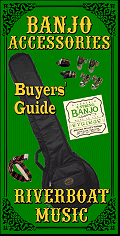

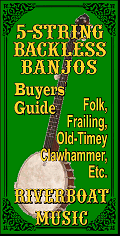

|

|
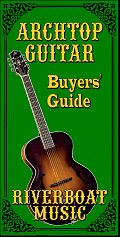
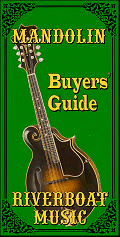
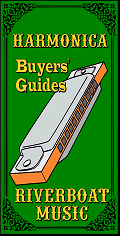
Beginning Five-String Folk Banjo - Part Four - Introduction to Melody
| Written by Paul Race for Creek Don't RiseTM and School Of The RockTM |
This is a follow-up to our article "Hammering On." We are talking exclusively about 5-string banjo here. Four-string and six-string banjos may be played many ways, but the 5-string can do certain things that they can't. So that's what we're focusing on in this article series.
I hope you're continuing to practice your rolls, including the hammering on "licks" we showed you in the last lesson. Because you'll never really move foward until you can do them all in your sleep. Remember the saying, "An amateur practices until he can play it right. A professional practices until he can't play it wrong."
At this point, you're ready to try playing a few simple melodies. This doesn't mean you should stop using the banjo to accompany you as you sing the melody. You need to learn to accompany yourself as well as to play melodies. One huge benefit to doing both is that when you do open mics or talent shows or whatever, you can play a fancy intro, sing the song, take an instrumental break, sing a last chorus, and play a fancy ending. I guarantee folks will be LOTS more impressed if you can both sing and play solos than if you can only do one or the other.
Thousands of folk, Bluegrass, Celtic, Country, and pop songs use only three chords. So as long as you don't mind playing in the key of G for now, you've got a lot of material to work with. Most of those songs also use a basic scale. For example, a song in the key of G will use the chords G, C, and D (or on banjo, D7sus4). And every note in the melody will be from the G scale (G-A-B-C-D-E-F#-G).
What makes playing banjo melodies for many three-chord songs relatively easy is that the main notes of the melodies are built right into the chord changes. That's especially true on our first banjo melody, the old three-chord, four-note fiddle tune "Boil That Cabbage Down." (Yes, most of my generation learned it from the Smothers Brothers, but it was a popular barn dance tune long before that.) To see the following staff in pdf sheet music format, click on the music.
To hear an mp3 of just the melody, click this icon: 
In this case we don't even need to use hammering on or similar devices to get the melody. We do have to play notes in their "second position." That is, the song starts on a B note, but you don't start out by playing that note on the second (B) string. Instead you play that B note on the fourth fret of the third string. Then, you play a B on the next beat as a part of your "strum" pulse.
The next note is a C, but you're in luck, because the song changes to a C chord, and there's a C note built right into that chord. And so on.
You already know the three chords you need for this song:
 |
 |
 |
The four notes you need for this song, B, C, A, and G, are built right into those three chords (remember, the initial B may also be played on the fourth fret of the third string).
(On a G Chord | (on a C Chord) | (on a D7sus4 Chord | (On a G Chord |
 |
 |
 |
 |
Basic Melody
The tabulature below shows a very basic version of this melody, with no hammering on or any other fancy stuff.
To hear the banjo part by itself (without a separate melody), click this icon: 
To hear a melody played along with the banjo, click this icon. 
To see a high-resolution PDF of this arrangement, simply click on the music.

Note that nearly every note in the melody is automatically played as part of your banjo roll. Yes, I deliberately chose a song where that would work out this way, but it happens more often than you might think.
This doesn't always work out, however. When you start making your own arrangements of traditional songs, pay attention to where the melody notes align with the roll you plan to be playing, and where they don't.
 When I started trying to figure out "the video thing," I made a short video of myself showing how to play this song. I went back through the best take and clipped out everywhere I went "uh," and so on, so it's a little choppy. The main criticism I've had of it is that I don't move in so you can see the chords properly. But the video was supposed to be a supplement to this page. It shows the part above this, then gets a little into hammering on, which is the next section.
When I started trying to figure out "the video thing," I made a short video of myself showing how to play this song. I went back through the best take and clipped out everywhere I went "uh," and so on, so it's a little choppy. The main criticism I've had of it is that I don't move in so you can see the chords properly. But the video was supposed to be a supplement to this page. It shows the part above this, then gets a little into hammering on, which is the next section.
Please click here to see the video.
Adding Hammering On
The tabulature below shows you addng the bluegrass lick on G that you learned in the last lesson. Hope you practiced up, because it adds a lot of color to the piece. I also added an "alternating bass" part on the one chord that it could be played on (the D7sus4 in measure 4). If you don't like how the low D sounds in that measure (not everybody does), just play the A on the third string again like you did in the version above.
To hear the banjo part by itself (without a separate melody), click this icon: 
To hear a melody played along with the banjo, click this icon. 
To see a high-resolution PDF of this arrangement, simply click on the music.

Add Passing Tones
As you've probably figured out, not all melody notes are built into the chords as conveniently as they are in the tune above. Most melodies include notes that briefly conflict with the notes in the chord. These are called passing tones. In most folk-based songs, the passing tones come from the scale of the key, which makes them predictable once you've figured out a few of them. So, for example, in the key of G, the passing tones will usually all be in the G scale.
The following picture shows the notes of the G scale as they're played in their lowest (or "root") position. I didn't put which fingers to use when playing them because that depends on what else is going on.
You may have noticed that a lot of teachers start you out on scales, and that's not necessarily a bad thing. We just chose to introduce this scale when some of the notes on it were about to come in handy. That said, you'd do well to practice this scale going up and down just to improve your familiarity with the banjo's neck.
You're probably used to hearing scales start on the "tonic" and go up to the tonic and back. If you start this scale on the G and go up to the high G it will sound like what you're used to. But you need to know the notes below that G, so we're starting on the lowest note you can play on a 5-string in "G" tuning.
To download a pdf "poster" version of this illustration, and a little more, right-click on the graphic.
To hear the scale, click this icon: 

"This Little Light" Redux
For our next example, we are revisiting "This Little Light of Mine." It only has one note you haven't used so far, an F# played by fretting the fourth string at the fourth fret. It also uses the version of "B" that is played on the fourth fret of the third string, just like we did our first version of "Boil That Cabbage Down."
You'll notice that the roll you've been using is interrupted several times by two quarter notes in a row. Ordinarily they come "slow enough" for you to play both notes with whatever finger you're using to pick the first note of each measure. For example, a three-finger picker will usually pick these notes with his or her index finger. Then you're back into your roll pattern for hte next beat. One advantage of learning your rolls very well by now is that you can keep a steady beat as you come in and out of them.
By they way, this song starts with a melodic phrase that is used in thousands of traditional songs. So learning this song will put you well on the road to learning countless others, including "Do, Lord" (which has nearly the same tune as "This Little Light of Mine"), as well as many old spirituals and hymns like, "Lonesome Valley," "I've got Peace Like a River," "Brethren, We Have Met to Worship," and "Power in the Blood."
To hear the banjo part by itself (without a separate melody), click this icon: 
To hear a melody played along with the banjo, click this icon. 
To see a high-resolution PDF of this arrangement, simply click on the music.

Once you've figured this out, and can play it comfortably, try adding that Bb-to-B Bluegrass lick on the first beat measures 3 and 11. You can also add the D-to-E hammer on the first beat of measure 5.
To hear this banjo part, click this icon: 

Conclusion
When you're practicing "This Little Light," practicing singing a verse, using the accompaniment you learned in lesson 2, then soloing using the version above. Getting used to going back and forth will soon put you ahead of a lot of other folks.In our next lesson, we'll add a couple more techniques that will help you play many, many more songs.
In the meantime please contact us if you have any questions or hit any brick walls.
All material, illustrations, and content of this web site is copyrighted © 2001, 2002, 2003, 2004, 2005, 2006,
2007, 2008, 2009, 2010, 2011, 2012, 2013, 2014, 2015 by Paul D. Race. All rights reserved.
Creek Dont' Rise(tm) is a participant in the Amazon Services LLC Associates Program, an affiliate advertising
program designed to provide a means for sites to earn advertising fees by advertising and linking to Amazon.com.
For questions, comments, suggestions, trouble reports, etc. about this play or about this web page, please contact us.
| Visit related pages and affiliated sites: | ||||||
| - Music - | ||||||

|
 |
 |

|

|

|
|

|

|

|

|

|

|
|
| - Trains and Hobbies - | ||||||
 |

|

|  |
 |

|
|
| - Christmas Memories and Collectibles - | ||||||
 |

|
 |

|
 |

|
|
| - Family Activities and Crafts - | ||||||
 |

|

|

|

|

|
|

